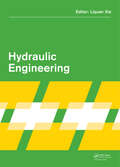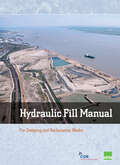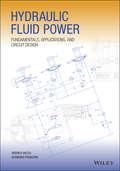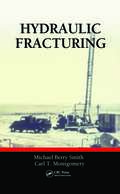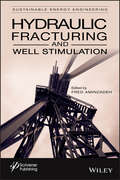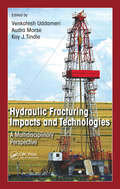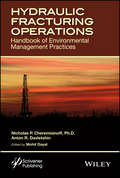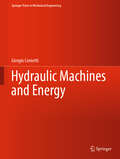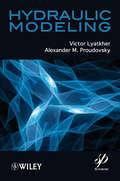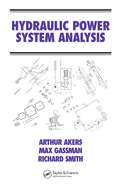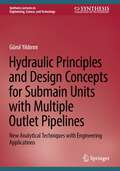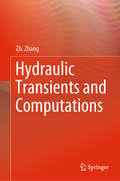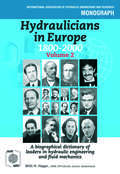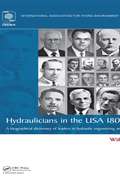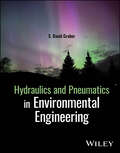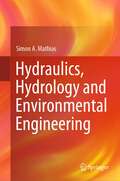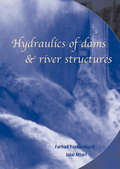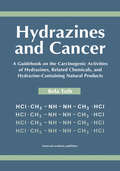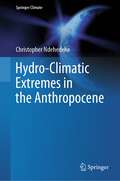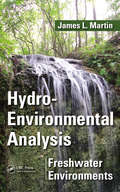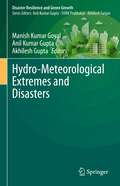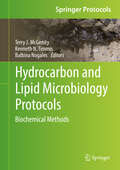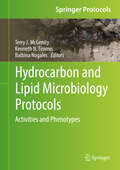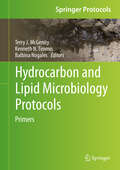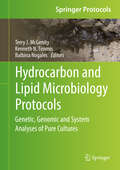- Table View
- List View
Hydraulic Engineering
by Liquan XieHydraulic Engineering contains 56 technical papers from the 2012 SREE Conference on Hydraulic Engineering (CHE 2012, Hong Kong, 21-22 December 2012, including the second SREE Workshop on Environment and Safety, WESE 2012). The conference served as a major forum for researchers, engineers and manufacturers to share recent advances, discuss problems,
Hydraulic Fill Manual: For Dredging and Reclamation Works
by Jan van ‘t Hoff Art Nooy van der KolffWithout proper hydraulic fill and suitable specialised equipment, many major infrastructure projects such as ports, airports, roads, industrial or housing projects could not be realised. Yet comprehensive information about hydraulic fill is difficult to find. This thoroughly researched book, written by noted experts, takes the reader step-by-step through the complex development of a hydraulic fill project. Up-to-date and in-depth, this manual enables the client and consultant to understand and properly plan a reclamation project. It provides adequate guidelines for design and quality control and allows the contractor to work within known and generally accepted guidelines and reasonable specifications. The ultimate goal is to create better-designed, more adequately specified, and less costly hydraulic fill projects.
Hydraulic Fluid Power: Fundamentals, Applications, and Circuit Design
by Andrea Vacca Germano FranzoniLearn more about hydraulic technology in hydraulic systems design with this comprehensive resource Hydraulic Fluid Power provides readers with an original approach to hydraulic technology education that focuses on the design of complete hydraulic systems. Accomplished authors and researchers Andrea Vacca and Germano Franzoni begin by describing the foundational principles of hydraulics and the basic physical components of hydraulics systems. They go on to walk readers through the most practical and useful system concepts for controlling hydraulic functions in modern, state-of-the-art systems. Written in an approachable and accessible style, the book’s concepts are classified, analyzed, presented, and compared on a system level. The book also provides readers with the basic and advanced tools required to understand how hydraulic circuit design affects the operation of the equipment in which it’s found, focusing on the energy performance and control features of each design architecture. Readers will also learn how to choose the best design solution for any application. Readers of Hydraulic Fluid Power will benefit from: Approaching hydraulic fluid power concepts from an “outside-in” perspective, emphasizing a problem-solving orientation Abundant numerical examples and end-of-chapter problems designed to aid the reader in learning and retaining the material A balance between academic and practical content derived from the authors’ experience in both academia and industry Strong coverage of the fundamentals of hydraulic systems, including the equations and properties of hydraulic fluids Fluid Power Fundamentals is perfect for undergraduate and graduate students of mechanical, agricultural, and aerospace engineering, as well as engineers designing hydraulic components, mobile machineries, or industrial systems.
Hydraulic Fracturing (Emerging Trends and Technologies in Petroleum Engineering)
by Michael Berry Smith Carl MontgomeryHydraulic Fracturing effectively busts the myths associated with hydraulic fracturing. It explains how to properly engineer and optimize a hydraulically fractured well by selecting the right materials, evaluating the economic benefits of the project, and ensuring the safety and success of the people, environment, and equipment. From data estimation
Hydraulic Fracturing and Well Stimulation
by Fred AminzadehHydraulic fracturing (or “fracking”) has been a source of both achievement and controversy for years, and it continues to be a hot-button issue all over the world. It has made the United States an energy exporting country once again and kept the price of gasoline low, for consumers and companies. On the other hand, it has been potentially a dangerous and destructive practice that has led to environmental problems and health issues. It is a deeply important subject for the petroleum engineer to explore as much as possible. This collection of papers is the first in the series, Sustainable Energy Engineering, tackling this very complex process of hydraulic fracturing and its environmental and economic ramifications. Born out of the journal by the same name, formerly published by Scrivener Publishing, most of the articles in this volume have been updated, and there are some new additions, as well, to keep the engineer abreast of any updates and new methods in the industry. Truly a snapshot of the state-of-the-art, this groundbreaking volume is a must-have for any petroleum engineer working in the field, environmental engineers, petroleum engineering students, and any other engineer or scientist working with hydraulic fracturing.
Hydraulic Fracturing Impacts and Technologies: A Multidisciplinary Perspective
by Venkatesh Uddameri Audra Morse Kay J. TindleHydraulic Fracturing Impacts and Technologies: A Multidisciplinary Perspective serves as an introduction to hydraulic fracturing and provides balanced coverage of its benefits and potential negative effects. Presenting a holistic assessment of hydraulic fracturing and its environmental impacts, this book chronicles the history and development of un
Hydraulic Fracturing Operations: Handbook of Environmental Management Practices
by Nicholas P. Cheremisinoff Anton DavletshinHydraulic fracturing, commonly referred to as “fracking,” is a technique used by the oil and gas industry to mine hydrocarbons trapped deep beneath the Earth’s surface. The principles underlying the technology are not new. Fracking was first applied at the commercial level in the United States as early as 1947, and over the decades it has been applied in various countries including Canada, the UK, and Russia. The author worked with engineering teams as early as the mid-1970s in evaluating ways to improve oil recovery from this practice. By and large fracking was not an economically competitive process and had limited applications until the early 2000s. Several factors altered the importance of this technology, among them being significant technological innovations in drilling practices with impressive high tech tools for exploration, well construction and integrity, and recovery along with discoveries of massive natural gas reserves in the United States and other parts of the world. These factors have catapulted the application of the technology to what is best described as the gold rush of the 21st century, with exploration and natural gas plays proceeding at a pace that seemingly is unrivaled by any historical industrial endeavor. But this level of activity has invoked widespread criticism from concerned citizens and environmental groups in almost every nation across the Globe. This outstanding new volume offers the industry a handbook of environmental management practices that can mitigate risks to the environment and, through best practices and current technologies, to conform to the current standards and regulations that are in place to provide the world with the energy it needs while avoiding environmental damage. For the new hire, veteran engineer, and student alike, this is a one-of-a-kind volume, a must-have for anyone working in hydraulic fracturing.
Hydraulic Machines and Energy (Springer Tracts in Mechanical Engineering)
by Giorgio CornettiThis first volume of the textbook Hydraulic and Thermal Machines introduces readers to all necessary fundamentals to understand and operate hydraulic and thermal machines. No prior knowledge in machinery is required. With an uncomplicated yet rigorous approach, it gradually guides bachelor students, with no prior knowledge in machines, from basic concepts such as dimensions and SI base and derived units, to more complex, mathematical and mechanical fundamentals of hydraulic machines, energy conversion processes, fluids, including real ones, as well as hydrostatics and hydrodynamics. In turn, the book gets into the basic structure and operating modes of pumps and turbines, ending up with the study of fluid dynamic transmission in hydraulic machines. Numerous examples are analyzed in detail, for a comprehensive understanding and effective learning, which will prepare readers to the second volume of this set.
Hydraulic Modeling
by Alexander M. Proudovsky Victor M. LyatkherWater. Except for air, it is the most important ingredient to all life on Earth. It surrounds us every day. We are literally bathed in it, we cook our food with it, and we need a steady stream of it in our bodies every single day just to survive. But water, and the study of it, is one of the most important and unheralded branches of engineering, affecting every other aspect of engineering in almost every industry. We harness its power for energy, we inject massive blasts of it into the earth to extract oil, gas, and minerals, and we use it in nearly every single industrial application, including food processing, refining, manufacturing, and waste disposal, just to name a few. Hyraulic modeling is, essentially, the understanding and prediction of fluid flow and its applications in industrial, municipal, and environmental settings, whether in a creekbed, locked in the pores of rocks deep in the earth, or in the ocean. Mathematical models, which started out with mechanical pencils and drafting tables originally, have been increasingly relied upon over the last few decades, due to the invention, growth, and refinement of computers. Physical modeling, however, is still practiced in laboratories, and it is the intersection of physical and mathematical modeling of fluid flow that is most successful in creating models that are safer, less costly, and are better for the environment. Hydraulic Modeling introduces and explores this incredibly important science, from the most basic tenets to valuable real-world applications that are used in industry today. It is the only volume on the market to offer a thorough coverage of the subject without adding lots of useless fluff or inapplicable appendices. It is a must-have for any engineer, scientist, or student working with hydraulic modeling, as a daily reference or a textbook.
Hydraulic Power System Analysis (Fluid Power and Control)
by Arthur Akers Max Gassman Richard SmithThe excitement and the glitz of mechatronics has shifted the engineering community's attention away from fluid power systems in recent years. However, fluid power still remains advantageous in many applications compared to electrical or mechanical power transmission methods. Designers are left with few practical resources to help in the design and
Hydraulic Principles and Design Concepts for Submain Units with Multiple Outlet Pipelines: New Analytical Techniques with Engineering Applications (Synthesis Lectures on Engineering, Science, and Technology)
by Gürol YıldırımThis book provides a state-of-the-art review of recent analytical developments on multi-outlets pipe flow hydraulics and alternative hydraulic design concepts. For this purpose, the book presents simple, but sufficiently accurate analytical equations, that can be applied directly without needing any numerical technique to achieve whole hydraulic computations. The analytical procedures explained here give an opportunity for designers to better understand the basic hydraulic principles of multi-outlet pipe flow, and demonstrate their applicability and efficiency to design problems of multi-outlet sub-main lines, covering various design configurations.
Hydraulic Transients and Computations
by Zh. ZhangThis book describes the fundamental phenomena of, and computational methods for, hydraulic transients, such as the self-stabilization effect, restriction of the Joukowsky equation, real relations between the rigid and elastic water column theories, the role of wave propagation speed, mechanism of the attenuation of pressure fluctuations, etc. A new wave tracking method is described in great detail and, supported by the established conservation and traveling laws of shockwaves, offers a number of advantages. The book puts forward a novel method that allows transient flows to be directly computed at each time node during a transient process, and explains the differences and relations between the rigid and elastic water column theories. To facilitate their use in hydropower applications, the characteristics of pumps and turbines are provided in suitable forms and examples. The book offers a valuable reference guide for engineers and scientists, helping them make transient computations for their own programming, while also contributing to the final standardization of methods for transient computations.
Hydraulicians in Europe 1800-2000: Volume 2 (IAHR Monographs)
by Willi HagerMore than 850 individuals partly forgotten by name, but sometimes found in historical writings, together with many well known or recently deceased persons are presented in terms of bio-data, short career highlights, and main advances made to the profession with a short biography of the main writings. If available, a portrait is also included.
Hydraulicians in the USA 1800-2000: A biographical dictionary of leaders in hydraulic engineering and fluid mechanics (IAHR Monographs)
by Willi H. HagerThis book provides 1-page short biographies of scientists and engineers having worked in the areas of hydraulic engineering and fluid dynamics in the USA. On each page, a notable individual is highlighted by: (1) Exact dates and locations of birth and death; (2) Educational and professional details, including also awards received; (3) Rea
Hydraulics and Pneumatics in Environmental Engineering
by S. David GraberBring the tools of hydraulics and pneumatics to bear on key environmental challenges Hydraulics and pneumatics are essential tools in environmental engineering. Any area of engineering which deals with harnessing, managing, and controlling fluid and flow will find hydraulics and pneumatics indispensable, and environmental engineering is no exception. These two subjects, however, are rarely integrated in standard teaching and research resources, and there exists an urgent need for a work which brings them together. Hydraulics and Pneumatics in Environmental Engineering meets this need with a thorough, accessible overview of this vital subject. Written for advanced environmental engineering students and assuming a sound undergraduate background in fluid mechanics, this book otherwise provides everything needed to bring hydraulic and pneumatic tools and principles to bear on environmental engineering problems. With civil and environmental engineering only becoming more essential as communities grow and the challenges of climate change mount, the next generation of engineers will be amply served by this text. Hydraulics and Pneumatics in Environmental Engineering readers will also find: An emphasis on practical applications, often under-valued in civil engineering courses Detailed discussion of topics including Navier-Stokes, G-Value, incompressible flow, and many more Diagrams and figures throughout to illustrate key points Hydraulics and Pneumatics in Environmental Engineering is ideal for graduate and advanced undergraduate students in civil and environmental engineering, as well as for researchers and practicing engineers in need of a reference.
Hydraulics, Hydrology and Environmental Engineering
by Simon A. MathiasThis textbook provides an excellent resource for engineering and science students to develop basic, intermediate and advanced level skills in hydraulics, hydrology and environmental engineering. Topics include open channel flow, ocean waves, kinematic wave modelling, flood forecasting, groundwater production, evapotranspiration, rainfall runoff modelling, cost benefit analysis, environmental evaluation, air quality control, carbon capture and storage, atmospheric dispersion, water pollution, water treatment, wastewater treatment, environmental impact assessment and uncertainty management. Hydrology and environmental engineering are treated as clear extensions of fluid mechanics and thermodynamics. Emphasis is placed on distinguishing between theoretical and empirical results. Written challenges are specified throughout the text to help readers derive important theoretical results for themselves. Each chapter includes a set of related practical problems with detailed worked solutions, many of which include short, self-contained MATLAB codes. The book provides a wealth of theoretical and practical exercises to aid teachers in planning innovative learning experiences for their students in class and at home. The book also offers a rich environment for students and researchers to practice mathematics and learn about the art of deriving analytical solutions in an environmental engineering context.
Hydraulics of Dams and River Structures: Proceedings of the International Conference, Tehran, Iran, 26-28 April 2004
by Farhad Yazdandoost Jalal AttariThis book comprises the papers of the International Conference on Hydraulics of Dams and Rivers Structures, held in Tehran, 26-28 April 2004. The topics covered include air-water flows, intakes and outlets, hydrodynamic forces, energy dissipators, stepped spillways, scouring and sedimentation around structures, numerical approaches in river hydrody
Hydrazines and Cancer: A Guidebook on the Carciognic Activities of Hydrazines, Related Chemicals, and Hydrazine Containing Natural Products
by Bela TothThis comprehensive publication on biological actions of hydrazines includes all the available published material and chronological descriptions of the literature. The uniformly applied principle of evaluations separates each hydrazine chemical and divides according to species. This monograph presents data on carcinogenic activity of hydrazines in a
Hydro-Climatic Extremes in the Anthropocene (Springer Climate)
by Christopher NdehedeheThis book explores how human civilization has contributed to changes in the Anthropocene, an era that marks a fundamental change in the way mankind has interacted with the Earth system. It examines the 21st century in the context of human development of water infrastructures, climate change impacts on freshwater resources, groundwater depletion, rising population, land use change, extreme events (droughts, floods, and wildfires). The implications of climate change impacts on environmental assets and the global water cycle are also highlighted. The book takes a pragmatically trans-disciplinary and holistic approach to the discussion of these issues, and the Earth system in the Anthropocene, drawing from a plethora of case studies. The capabilities of machine learning tools in satellite hydrology applications have been demonstrated as well as the feasibility of remote sensing data and innovative geospatial tools in environmental assessment. The book further showcases the multiple strengths and potential of new multi-disciplinary satellite radar programmes and geodetic missions, to measure and characterize extreme events, and their links to global climate, as well as in remote sensing of the environment. The aim is to provide innovative tools and a scientific framework that underpin our fundamental understanding of environmental systems, and the complexities of socio-hydrological systems in the Anthropocene. Policy issues have also been raised as an important aspect that can strengthen the management and administration of water resources, particularly in emerging economies where observational data is often lacking, limited, or difficult to access. It also highlights the lessons learned from freshwater hotspots (e.g., Lake Chad and Lake Urmia) where prolonged droughts and human activities have led to a permanent loss of surface water. It identifies the role of institutions and stakeholders in driving policies that underpins water management and climate change adaptation. The book articulates the novel applications of remote sensing tools as part of a monitoring framework that can alert stakeholders and the public sector to the dangers of mismanagement of freshwater in these hotspots and help facilitate water governance approaches. The book fills a critical gap in the multi-disciplinary aspect of planetary science, particularly in understanding the impacts of climate change and human actions on freshwater resources, as well as the stability of the Earth system.
Hydro-Environmental Analysis: Freshwater Environments
by James L. MartinFocusing on fundamental principles, Hydro-Environmental Analysis: Freshwater Environments presents in-depth information about freshwater environments and how they are influenced by regulation. It provides a holistic approach, exploring the factors that impact water quality and quantity, and the regulations, policy and management methods that are ne
Hydro-Meteorological Extremes and Disasters (Disaster Resilience and Green Growth)
by Manish Kumar Goyal Anil Kumar Gupta Akhilesh GuptaThe edited book provides both fundamentals as well as key factors of climate change, extreme events and disaster risk management. It systematically describes the integrated risk of various hydro-meteorological extreme events. The book brings together broad range of topics including basic concepts, exposure, risk, resilience and vulnerability. In addition, it also analysis the impact of various disaster events on bio-diversity, local communities, ecosystem and agricultural food production. The motive is to define remediation strategies in the fields of resilient infrastructures, communication strategies and immediate public participation. The book is presented in four parts, where part 1 familiarizes with fundamentals of hydro-meteorological based disasters; Part 2 focuses on risk and vulnerability analysis; Part 3 focuses on risk remediation options; and part 4 suggests the role of sustainable planning framework on disaster risk management. This volume is of interest and use to professionals and researchers working in climate change, atmospheric sciences and disaster management.
Hydrocarbon and Lipid Microbiology Protocols
by Terry J. Mcgenity Kenneth N. Timmis Balbina NogalesThis Volume addresses the pros and cons of oligonucleotide probes, primers and primer combinations, and importantly considers how to design the best tools for the microbial taxa and/or processes being investigated. Individual chapters focus on the design of primers targeting genes that code for enzymes associated with the following functions: degradation of aromatic, aliphatic and chlorinated hydrocarbons under aerobic and anaerobic conditions, methanogenesis, methane oxidation, and the nitrogen cycle. Hydrocarbon and Lipid Microbiology Protocols There are tens of thousands of structurally different hydrocarbons, hydrocarbon derivatives and lipids, and a wide array of these molecules are required for cells to function. The global hydrocarbon cycle, which is largely driven by microorganisms, has a major impact on our environment and climate. Microbes are responsible for cleaning up the environmental pollution caused by the exploitation of hydrocarbon reservoirs and will also be pivotal in reducing our reliance on fossil fuels by providing biofuels, plastics and industrial chemicals. Gaining an understanding of the relevant functions of the wide range of microbes that produce, consume and modify hydrocarbons and related compounds will be key to responding to these challenges. This comprehensive collection of current and emerging protocols will facilitate acquisition of this understanding and exploitation of useful activities of such microbes.
Hydrocarbon and Lipid Microbiology Protocols
by Terry J. Mcgenity Kenneth N. Timmis Balbina NogalesThis Volume addresses the pros and cons of oligonucleotide probes, primers and primer combinations, and importantly considers how to design the best tools for the microbial taxa and/or processes being investigated. Individual chapters focus on the design of primers targeting genes that code for enzymes associated with the following functions: degradation of aromatic, aliphatic and chlorinated hydrocarbons under aerobic and anaerobic conditions, methanogenesis, methane oxidation, and the nitrogen cycle. Hydrocarbon and Lipid Microbiology Protocols There are tens of thousands of structurally different hydrocarbons, hydrocarbon derivatives and lipids, and a wide array of these molecules are required for cells to function. The global hydrocarbon cycle, which is largely driven by microorganisms, has a major impact on our environment and climate. Microbes are responsible for cleaning up the environmental pollution caused by the exploitation of hydrocarbon reservoirs and will also be pivotal in reducing our reliance on fossil fuels by providing biofuels, plastics and industrial chemicals. Gaining an understanding of the relevant functions of the wide range of microbes that produce, consume and modify hydrocarbons and related compounds will be key to responding to these challenges. This comprehensive collection of current and emerging protocols will facilitate acquisition of this understanding and exploitation of useful activities of such microbes.
Hydrocarbon and Lipid Microbiology Protocols
by Terry J. Mcgenity Kenneth N. Timmis Balbina NogalesThis Volume addresses the pros and cons of oligonucleotide probes, primers and primer combinations, and importantly considers how to design the best tools for the microbial taxa and/or processes being investigated. Individual chapters focus on the design of primers targeting genes that code for enzymes associated with the following functions: degradation of aromatic, aliphatic and chlorinated hydrocarbons under aerobic and anaerobic conditions, methanogenesis, methane oxidation, and the nitrogen cycle. Hydrocarbon and Lipid Microbiology Protocols There are tens of thousands of structurally different hydrocarbons, hydrocarbon derivatives and lipids, and a wide array of these molecules are required for cells to function. The global hydrocarbon cycle, which is largely driven by microorganisms, has a major impact on our environment and climate. Microbes are responsible for cleaning up the environmental pollution caused by the exploitation of hydrocarbon reservoirs and will also be pivotal in reducing our reliance on fossil fuels by providing biofuels, plastics and industrial chemicals. Gaining an understanding of the relevant functions of the wide range of microbes that produce, consume and modify hydrocarbons and related compounds will be key to responding to these challenges. This comprehensive collection of current and emerging protocols will facilitate acquisition of this understanding and exploitation of useful activities of such microbes.
Hydrocarbon and Lipid Microbiology Protocols
by Terry J. Mcgenity Kenneth N. Timmis Balbina NogalesThis Volume addresses the pros and cons of oligonucleotide probes, primers and primer combinations, and importantly considers how to design the best tools for the microbial taxa and/or processes being investigated. Individual chapters focus on the design of primers targeting genes that code for enzymes associated with the following functions: degradation of aromatic, aliphatic and chlorinated hydrocarbons under aerobic and anaerobic conditions, methanogenesis, methane oxidation, and the nitrogen cycle. Hydrocarbon and Lipid Microbiology Protocols There are tens of thousands of structurally different hydrocarbons, hydrocarbon derivatives and lipids, and a wide array of these molecules are required for cells to function. The global hydrocarbon cycle, which is largely driven by microorganisms, has a major impact on our environment and climate. Microbes are responsible for cleaning up the environmental pollution caused by the exploitation of hydrocarbon reservoirs and will also be pivotal in reducing our reliance on fossil fuels by providing biofuels, plastics and industrial chemicals. Gaining an understanding of the relevant functions of the wide range of microbes that produce, consume and modify hydrocarbons and related compounds will be key to responding to these challenges. This comprehensive collection of current and emerging protocols will facilitate acquisition of this understanding and exploitation of useful activities of such microbes.
